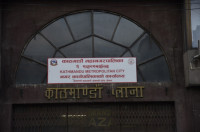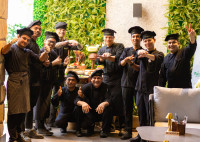Food
Man Tang Hong might not be the cleanest or the most refined, but it’s Sichuan cuisine is often good, sometimes bad—it’s a gamble.
For this review, Hantakali chose Man Tang Hong, a restaurant popular among Chinese tourists and Nepalis in-the-know.
Hantakali
If someone who has never been to Kathmandu was airdropped into Jyatha, Thamel, they’d have a hard time figuring out if they had landed in Nepal or a bustling strip in a quaint Chinese town. Every other building along this strip in the heart of Kathmandu is either a Chinese-run hotel, a restaurant or a shop, all with tongue-twisting Chinese names.
It was in one of these Chinese restaurants that Hantakali got their first taste of Sichuan cuisine, almost four years ago. That restaurant has been lost to time, as it closed down nearly two years ago. But Hantakali remembers fondly that cold winter evening and the Laziji, thumb-sized pieces of deep-fried chicken in a heaping mound of dried chillies and Sichuan peppercorns. Since then, there’s been no going back.
There are a plethora of choices down this side Thamel street, from fine dining to hole-in-the-wall spots with menus on the wall, all in Chinese. But for this review, Hantakali chose Man Tang Hong, a restaurant popular among Chinese tourists and Nepalis in-the-know. Amid the many, many choices, it can be hard to locate, but it’s a way down the street and up a flight of stairs. Google maps can help.
In terms of decor, Man Tang Hong is a fairly typical Sichuan restaurant, in that there is none. No stereotypical prints of Chinese paintings on the walls, no randomly placed Chinese characters and no one’s dressed in a cheongsam. The restaurant is actually reminiscent of cheap Chinese-American joints in the United States—a bare-bones layout with tables and chairs, slightly filthy, smelling of food and unmentionables. The round tables are typical of Chinese culinary etiquette, where everyone shares the food, and so there’s a revolving Lazy Susan in the centre. For larger, more boisterous groups, two private rooms are also available.

Interior of Man Tang Hong.
But ignore the decor and those crumpled napkins and discarded beer bottles tucked indiscreetly into various corners. No one comes here because it’s a pretty place. Let’s bring on the food.
The one dish that anyone visiting Man Tang Hong should try is the Laziji. You might have to hunt for pieces of chicken in that humongous pile of red chillies and Sichuan peppercorns, but each morsel is worth the search. The chicken is crunchy on the outside and soft and moist on the inside. Given the amount of chilies, you might expect the chicken to be fiery but it’s really not—just spicy enough to add that peppercorn tingle to your tongue. But be warned, those red chillies are spicier than they look. Even Hantakali, who is no stranger to heat, was sweating, sniffling and tingling.
Next up was the Dou Pal Yu—steamed whole fish in bean sauce—recommended by a Chinese friend, an expat in Kathmandu. Apparently, this fish is very popular at Man Tang Hong with Chinese expats and tourists. Dou pal means bean sauce in Chinese, and yu is fish, Hantakali was told. Man Tang Hong uses local rohu fish for this dish. The rohu is taken fresh from its fish tank, which is at the entrance to the restaurant. The whole fish is first steamed, then a bubbling hot stew of soybean sauce with fried chopped onions, garlic and bits and pieces of chilli flakes are doused over it. It is then topped with scallions and cilantro.

The rohu was steamed to perfection. The tender meat could be pulled easily from the bones, and the sauce, though oily enough to clog your arteries, complemented the fish very well, with the chili flakes lending a gentle touch of heat. Paired with rice, it's an absolute delight.
A dish that Hantakali ordered, at the behest of the friend, was double-cooked pork, a must-try at Man Tang Hong. The pork is first boiled, then stir-fried with chunks of capsicum and green onion stems, hence its name. It sounded good, but it didn’t taste half as good. The pork was very dry, with an unpleasant and unappetising odour.
Another dish that disappointed Hantakali was the Xi Hong Shi Chao Ji Dan Fan Qie—stir-fried eggs with tomatoes—a Sichuan classic. The eggs had clearly not been beaten well—the whites and yellows weren’t one smooth blend—and it seemed to have been left in the wok a little longer than necessary. So while the eggs were rubbery, large pieces of tomato were raw. The two should’ve gone together perfectly but here, not at all.
The Qing Chao Xiao Bai Cai, however, redeemed Man Tang Hong. The dish of perfectly stir-fried baby bok choy leaves was savoury and garlicky. The bok choy was fried enough to maintain its crunch. The only problem will perhaps be for those unused to the chopstick, as the bok choy can be quite slippery. This dish, though, is a staple at Man Tang Hong. Another staple at Man Tang Hong and one that Hantakali orders on every visit is the shredded potatoes, a simple dish of shredded potatoes stir-fried with red chillies and thinly-cut capsicum.
Man Tang Hong is by no means refined. It’s not the tidiest establishment, and on weekends, it can get noisy and chaotic. The service isn’t polished either, and it is often inconsistent. But when all goes well, it excels at its food. And most of the times, that’s the only thing that matters.
Man Tang Hong: Rs 700-1,000
Food: ★★★★
Ambience: ★★
Value: ★★★★




 21.39°C Kathmandu
21.39°C Kathmandu










